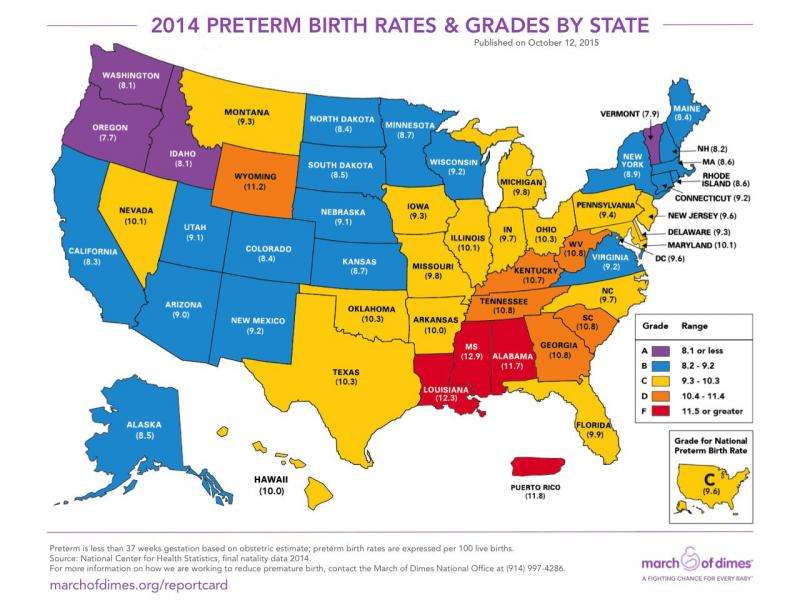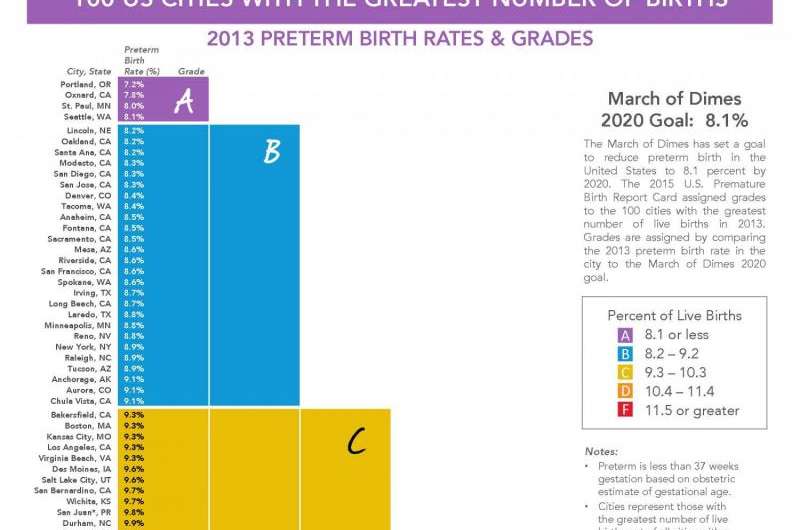March of Dimes Premature Birth Report Card grades cities; focuses on racial disparities

Portland, Oregon has the best preterm birth rate of the top 100 cities with the most births nationwide, while Shreveport, Louisiana has the worst, according to the 2015 March of Dimes Premature Birth Report Card, which for the first time graded cities and counties around the nation and revealed persistent racial, ethnic and geographic disparities within states.
The U.S. preterm birth rate ranks among the worst of high-resource countries, the March of Dimes says. Worldwide, 15 million babies are born preterm, and nearly one million die due to early birth or its complications. Babies who survive an early birth often face serious and lifelong health problems, including breathing problems, jaundice, vision loss, cerebral palsy and intellectual delays.
Portland's preterm birth rate was 7.2 percent, earning that city an "A" on the report card and Shreveport got an "F" for its 18.8 percent rate in 2013, the most recent year statistics were available for large cities.
The United States earned a "C" on the 8th annual report card with a preterm birth rate of 9.6 percent in 2014, according to the National Center for Health Statistics. The nation met the March of Dimes 2020 goal early, avoiding thousands of early births and saving millions in health care costs, the organization's leaders said. The March of Dimes also announced a new goal for the nation to lower the preterm birth rate to 8.1 percent of live births by 2020.
Despite the long term trend of better rates, premature birth is the leading cause of infant death and the number one killer of babies; and, within states, serious gaps exist among racial and ethnic groups, as well as between communities, the March of Dimes says.

"Reaching our goal ahead of schedule is progress, but it is not victory—our work is far from done," said Dr. Jennifer L. Howse, president of the March of Dimes. "As our new list of city preterm birth rates highlights, many areas of the country, and tens of thousands of families, are not sharing in this success. No baby should have to battle the health consequences of an early birth. All babies, everywhere deserve a healthy start in in life."
The 2015 Premature Birth Report Card provides rates and grades for major cities or counties in each state, and Puerto Rico. It also provides preterm birth rates by race and ethnicity for each state and applies a disparity index that ranks states.
Maine ranked first on the disparity index with the smallest gaps among racial and ethnic groups in its preterm birth rate, while the District of Columbia had the largest gaps.
Idaho, Oregon, Vermont and Washington earned "As," 19 states received a "B," 18 states and the District of Columbia got a "C," six others a "D," and Alabama, Louisiana, Mississippi and Puerto Rico received an "F."
In addition to Portland, Oxnard, California; St. Paul, Minnesota; and Seattle, Washington are the only other cities that earned "As" on the national report card.
The March of Dimes says progress in the US preterm birth rate came through bold leadership and the implementation of programs and policies by state and local health departments, hospitals and health care providers. Also, a more accurate method of measuring pregnancy length recently was adopted by the National Center for Health Statistics. The new measurement already is used by most other high-resource countries.
The March of Dimes says it recognizes that continued research to identify new medical advances to prevent preterm birth is necessary in order to reach the new goal. The March of Dimes is raising $75 million to support a nationwide network of five cutting-edge, team-based research centers seeking to find the unknown causes of preterm birth and ways to prevent it.
The March of Dimes Board of Trustees set a new goal to lower the national preterm birth rate to 8.1 percent by 2020 and to 5.5 percent by 2030. Reaching the March of Dimes 2020 goal of 8.1 will mean that 210,000 fewer babies will be born preterm and achieving the 2030 goal will mean 1.3 million fewer babies will be born preterm saving about $70 billion, the March of Dimes estimates.
"This aggressive goal can be achieved by increasing best practices in preconception and pregnancy care, wider use of proven interventions such as progesterone and birth spacing, and funding discovery research through our research centers," Dr. Howse says.


















